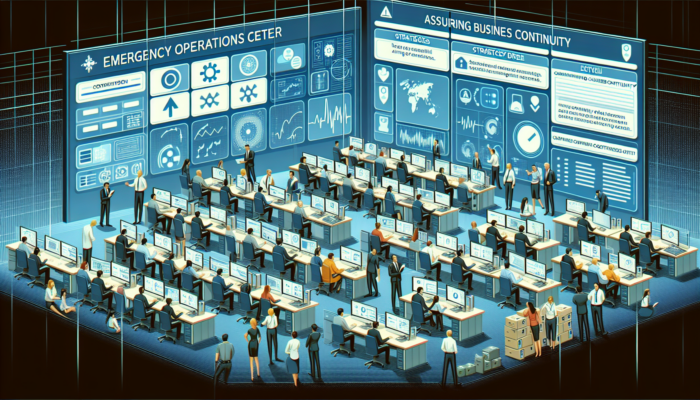In Crisis, We Respond: The Critical Role of Emergency Response in Customer Support
Introduction
During times of crisis, businesses face immense challenges in providing uninterrupted customer support. While customer support is crucial under normal circumstances, it becomes even more critical during times of crisis. In this article, we will explore the essential role of emergency response in customer support and how businesses can effectively handle such situations to ensure customer satisfaction and loyalty.
Understanding the Importance of Emergency Response in Customer Support
During a crisis, customers often experience heightened anxiety, uncertainty, and urgency. They rely on businesses for timely and accurate information, reassurance, and problem-solving. Prompt and effective customer support during these times can significantly impact a company’s reputation, customer loyalty, and overall success. Therefore, businesses must recognize the critical role of emergency response in customer support and prioritize it accordingly.
Key Elements of an Effective Emergency Response Plan
To ensure a seamless customer support experience during a crisis, businesses should have a well-defined emergency response plan in place. Here are some key elements to consider:
1. Clear Communication Channels
Establishing clear and reliable communication channels is paramount. Customers should have multiple avenues to reach out for support, including phone, email, live chat, and social media platforms. These channels should be regularly monitored, allowing businesses to promptly respond to customer queries and concerns.
- Phone: Provide a dedicated helpline number that is available 24/7. Ensure that calls are answered promptly and efficiently.
- Email: Create a dedicated email address for customer support during a crisis. Assign a team to monitor and respond to emails in a timely manner.
- Live Chat: Implement a live chat feature on your website to provide instant support to customers. Make sure the chat function is staffed by knowledgeable agents who can address customer concerns effectively.
- Social Media: Monitor social media platforms for customer inquiries and complaints. Respond promptly and professionally to maintain a positive brand image.
2. Proactive Customer Notifications
In a crisis, customers may have questions or require updates on service disruptions, delays, or safety precautions. Proactive notifications via email, SMS, or automated voice calls can help keep customers informed and minimize potential frustrations. Consistent and transparent communication builds trust and reassures customers that their needs are being addressed.
- Email notifications: Send regular updates to customers about any changes or disruptions to services. Be transparent about the steps being taken to address the situation and provide reassurance.
- SMS notifications: Send text messages to customers to communicate important updates or changes. This ensures that customers receive timely information, even if they are not actively checking their emails.
- Automated voice calls: Use automated voice calls to reach out to customers and provide critical information. This can be particularly useful for urgent announcements or safety instructions.
3. Flexible Workforce and Resources
A crisis often demands flexibility in workforce management. Businesses should have contingency plans in place to ensure an adequate number of customer support agents can be mobilized, even if it requires remote work arrangements. Additionally, having sufficient resources, such as call center technology, remote access tools, and robust knowledge bases, enables agents to provide uninterrupted assistance to customers.
- Remote work arrangements: Establish a system that allows customer support agents to work remotely during a crisis. Provide them with the necessary tools and technology to ensure they can continue delivering exceptional support.
- Call center technology: Invest in call center technology that enables agents to handle a high volume of customer inquiries efficiently. This may include features like call routing, call recording, and customer relationship management (CRM) integration.
- Robust knowledge bases: Create a comprehensive knowledge base that contains frequently asked questions, troubleshooting guides, and step-by-step instructions. This empowers agents to provide accurate and timely assistance to customers.
4. Empathetic and Well-Trained Support Agents
During a crisis, customers seek empathy and understanding. Support agents should be equipped with appropriate training to handle emotionally charged situations and exhibit empathy towards distressed customers. Training programs should focus on active listening, problem-solving, and providing accurate information to effectively address customer concerns.
- Active listening: Train support agents to actively listen to customers, showing empathy and understanding. Encourage them to ask open-ended questions to gather all necessary information and to make customers feel heard.
- Problem-solving skills: Provide agents with problem-solving techniques and frameworks to help them address customer issues effectively. This may involve providing them with decision trees or guidelines to follow when assisting customers with specific problems.
- Accurate information: Ensure that support agents have access to up-to-date information about the crisis and its impact on the business. This allows them to provide customers with accurate and relevant information, minimizing confusion and frustration.
5. 24/7 Availability
In times of crisis, customer support should be available 24/7. Emergencies don’t always adhere to regular business hours, and customers may require assistance at any time. Round-the-clock availability showcases a commitment to customer satisfaction and helps mitigate potential frustration and anxiety.
- Shift scheduling: Implement a shift schedule that covers customer support round-the-clock. This may involve having agents work in rotating shifts or outsourcing support to a third-party provider who can provide 24/7 coverage.
- On-call support: Designate a team of on-call support agents who can be reached outside of regular working hours. Ensure that these agents have access to the necessary resources and information to assist customers effectively.
6. Collaboration with Other Departments
During a crisis, customer support should collaborate closely with other departments, such as public relations, operations, and technical support. This ensures a coordinated response to customer inquiries and aligns all teams in delivering accurate and consistent messaging.
- Regular communication: Establish regular communication channels with other departments involved in the crisis response. This can be done through daily or weekly meetings to share updates, align strategies, and address any emerging issues.
- Cross-training: Consider cross-training support agents in other departments’ processes and procedures. This enables them to provide comprehensive support and ensures a smooth collaboration between teams.
- Shared knowledge base: Create a shared knowledge base or documentation repository where all relevant departments can access and contribute information. This promotes collaboration and ensures consistent messaging across the organization.
Best Practices for Emergency Response Customer Support
To provide exceptional customer support during a crisis, businesses can implement the following best practices:
1. Prioritize Urgency
During a crisis, response time is critical. Businesses should prioritize urgent customer inquiries and aim to provide timely resolutions. Implementing an automated triage system or assigning dedicated agents to handle urgent cases can help streamline the support process.
- Automated triage system: Develop an automated system that categorizes incoming customer inquiries based on urgency. This allows agents to prioritize their workload and ensures that urgent cases are addressed promptly.
- Dedicated agents: Assign dedicated agents or a specialized team to handle urgent cases. These agents should have the necessary expertise to quickly assess and resolve critical customer issues.
2. Maintain Transparency
Transparency builds trust and reassures customers. Businesses should provide regular updates on the status of services, known issues, and steps being taken to resolve them. Openly communicating any limitations or delays helps manage customer expectations and reduces frustration.
- Regular updates: Send regular updates to customers about the progress made in resolving issues or restoring services. Be honest about any limitations or delays, and provide realistic timelines for resolution.
- Open communication channels: Encourage customers to reach out with any concerns or questions they may have. Make it easy for them to provide feedback and ensure that their voices are heard.
3. Offer Self-Service Options
In addition to traditional support channels, businesses can offer self-service options, such as knowledge bases, FAQs, and community forums. These resources empower customers to find answers to common questions and minimize the burden on support agents. However, it’s essential to ensure these self-service options are regularly updated and easily accessible.
- Knowledge base: Create a comprehensive knowledge base that covers a wide range of topics and common customer inquiries. Keep it regularly updated with new information and ensure that it is easily searchable and accessible to customers.
- FAQs: Develop a set of frequently asked questions (FAQs) that address common concerns during a crisis. Make these FAQs readily available on your website or support portal.
- Community forums: Establish an online community forum where customers can interact with each other and share their experiences and solutions. Encourage active participation and provide moderation to ensure a positive and helpful environment.
4. Gather Customer Feedback
During a crisis, gathering customer feedback becomes even more valuable. Surveys, feedback forms, or sentiment analysis tools can help businesses gauge customer satisfaction levels and identify areas for improvement. Actively listening to customer feedback allows businesses to adapt and refine their emergency response strategies.
- Surveys and feedback forms: Create surveys or feedback forms that allow customers to provide their feedback on the support they received during the crisis. Ask specific questions about their experience and suggestions for improvement.
- Sentiment analysis tools: Utilize sentiment analysis tools to analyze customer feedback from various sources, such as social media or online reviews. This provides valuable insights into customer sentiment and identifies trends or patterns that need attention.
- Regular data analysis: Regularly analyze the feedback gathered to identify recurring issues or areas for improvement. Use this information to refine emergency response strategies and enhance the overall customer support experience.
5. Learn from Past Crises
Every crisis presents an opportunity to learn and improve. Businesses should conduct post-crisis evaluations to identify strengths and weaknesses in their emergency response plans. Analyzing customer feedback, agent performance, and overall effectiveness of the response helps organizations refine their processes for future crises.
- Post-crisis evaluation: Schedule a post-crisis evaluation meeting with key stakeholders involved in the emergency response. Discuss the strengths and weaknesses of the response and identify areas for improvement.
- Lessons learned documentation: Create a comprehensive document that captures the lessons learned from the crisis. Include recommendations for improvements in processes, tools, and communication strategies.
- Continual improvement: Regularly review and update the emergency response plan based on the lessons learned from past crises. Continually strive to enhance the effectiveness and efficiency of the response.
Conclusion
Emergency response plays a critical role in customer support, especially during times of crisis. By establishing clear communication channels, proactive notifications, and readily available resources, businesses can provide exceptional support, build customer loyalty, and safeguard their reputation. Implementing best practices, such as prioritizing urgency, maintaining transparency, offering self-service options, gathering feedback, and learning from past experiences, can further enhance the effectiveness of emergency response in customer support. By recognizing the importance of emergency response and dedicating resources to its execution, businesses can navigate through crises while maintaining strong relationships with their valued customers.
FAQ
Q1: Why is emergency response important in customer support?
A1: Emergency response is important in customer support because it helps businesses provide timely and accurate information, reassurance, and problem-solving during times of crisis. It impacts a company’s reputation, customer loyalty, and overall success.
Q2: What are the key elements of an effective emergency response plan for customer support?
A2: The key elements of an effective emergency response plan for customer support include clear communication channels, proactive customer notifications, a flexible workforce and resources, empathetic and well-trained support agents, 24/7 availability, and collaboration with other departments.
Q3: How can businesses prioritize urgency in emergency response customer support?
A3: Businesses can prioritize urgency in emergency response customer support by implementing an automated triage system that categorizes inquiries based on urgency and assigning dedicated agents or a specialized team to handle urgent cases.
Q4: What are some best practices for emergency response customer support?
A4: Some best practices for emergency response customer support include prioritizing urgency, maintaining transparency, offering self-service options, gathering customer feedback, and learning from past crises. These practices help businesses provide exceptional support and enhance their emergency response strategies.




